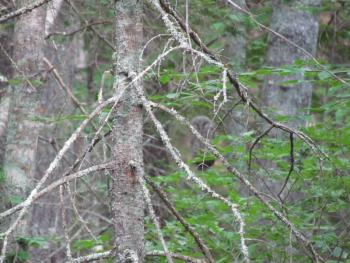A Good Season For Owls
Sister-in-law Nina called, breathless, a few weeks ago. While walking the dogs along a quiet road in Georgetown, she was astonished to find a tiny, newly fledged saw-whet owl sitting on the back of a small trailer in a neighbor’s wood lot. Fledgling saw-whet owls are a chocolate brown with an orangey belly and a white patch between the eyes. The dogs, of course, were quite interested in this new-found creature; the little owl was not happy with their interest. It exhibited some classic young owl behavior including hissing and loud snapping of the bill to signal that they should not even think about messing with it. Nina got the dogs away quickly and brought them home, then headed back to see if the bird was still there possibly in need of assistance. As so often happens, the young bird was apparently fine and had moved away to a more private setting to await the evening and the next meals that its parents would provide.
Nina was very fortunate to see a saw-whet-owl. They are not uncommon breeding birds in Maine, but are so nocturnal and secretive that even the most avid birders rarely see them. They can be detected more often by their song—a series of repeated whistled notes that sounds remarkably similar to the back-up signal of a truck. During fall migration, owl banders sometimes catch a remarkable number of them as well. But most of us will be lucky to ever see one in the wild.
Barred owls, on the other hand, are not only the most widespread and common owl species here in Maine but are also the one most likely to be seen. They are the only owl that regularly hoots during daylight hours, giving its characteristic “who-cooks-for-you, who-cooks-for-you-all” with great vigor.
On Father’s Day, we went down to Pemaquid Point and Harbor for some seafood and birding. We soaked in beautiful views of Monhegan Island and had fun looking through the scope for the little camp on Eastern Egg Rock that the Audubon staff call the Egg Rock Hilton. Down at the harbor we were delighted to have an elegant long-tailed roseate tern join the more numerous common terns that were foraging for fish.
On the way back home, we decided to stop off at a small preserve and listen for landbirds for a few minutes. Ovenbirds sang their “teacher-teacher-teacher.” A yellow-rumped warbler gave its sweet warble. And then a long hiss! And again!
It was the characteristic begging call of a baby barred owl!
We scanned through the trees, and about 75 feet away we spotted two dark eyes in a fluffy bundle. A young barred owl, just out of the nest! And there was another, sitting just a few feet below it! We were able to quietly set up the telescope and gaze at the bird close-up without disturbing it.
What a great Father’s Day treat and nice to know that at least several owl families in the area have had a good year!
Jeffrey V. Wells, Ph.D., is a Fellow of the Cornell Lab of Ornithology and Vice President of Boreal Conservation for National Audubon. Dr. Wells is one of the nation's leading bird experts and conservation biologists. He is a coauthor of the seminal “Birds of Maine” book and author of the “Birder’s Conservation Handbook.” His grandfather, the late John Chase, was a columnist for the Boothbay Register for many years. Allison Childs Wells, formerly of the Cornell Lab of Ornithology, is a senior director at the Natural Resources Council of Maine, a nonprofit membership organization working statewide to protect the nature of Maine. Both are widely published natural history writers and are the authors of the popular books, “Maine’s Favorite Birds” (Tilbury House) and “Birds of Aruba, Bonaire, and Curaçao: A Site and Field Guide,” (Cornell University Press).


.jpg)




























.png)

.png)
